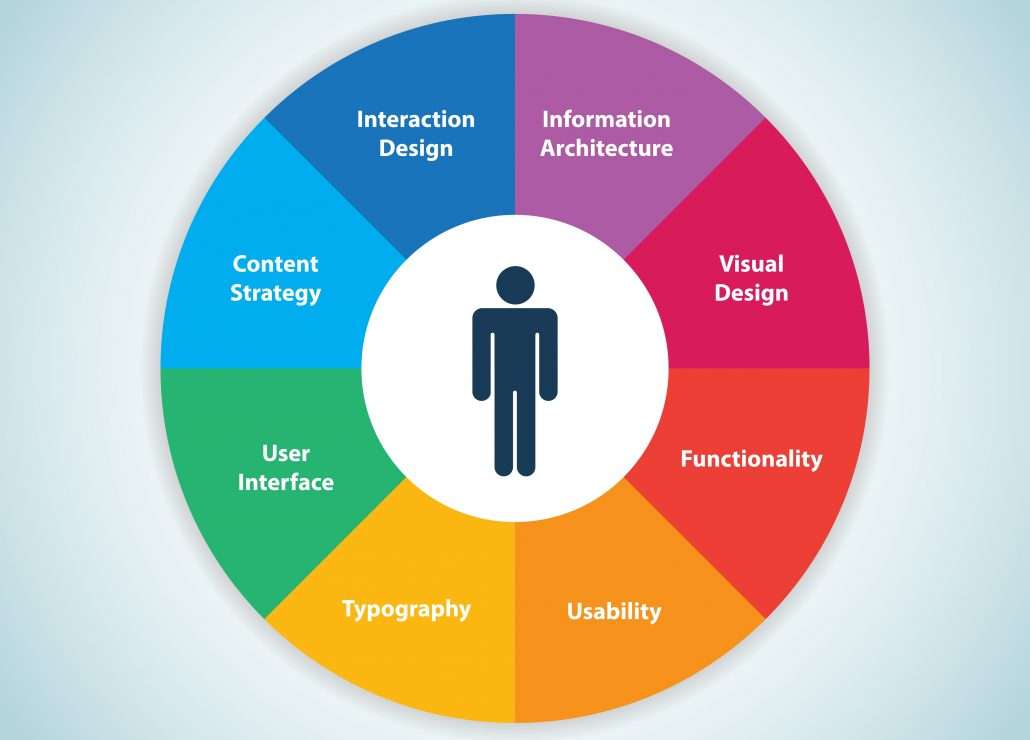{DEFINITION} User Experience Design (UXD or UED or XD) is the process of enhancing user satisfaction by improving the usability, accessibility, and pleasure provided in the interaction between the user and the product. So what exactly leads us to a successful user experience? And why is it so important for your website? Let’s explore the critical components. 
1. Visual Design
The visuals not only represent your brand, or the look and feel of your online space, they are extremely important when it comes to determining the user experience of your website. Beyond visuals, such as colours, visuals and logos, there’s a deeper element which involves effective visual communication. Your graphic treatment must help you drive business, and must of course, encourage ease of use, and clicking in all the right places. A User Experience Designer has the edge on a Graphic Designer in this department. Although they may be somewhat similar, there are some definitive differences in skill-set. Engaging with a User Experience Designer will give you the confidence that your designer really understands the needs of your users, your business and also the technology that is being used for your site (or app).
2. Information Architecture
The layout of your content is key to a smooth user experience. Create a flow for which you would ideally like your visitors to take, by mapping out a journey for them. Links, find-ability and usability of your site all come into play here. Don’t confuse people or take them to random places, maintain consistency throughout your site map and focus on the features and information which are important to your user.
3. Content Strategy & Structure
Not the same as architecture, structure focuses on the all important clarity of your messaging. Make sure your content is clear from the get go i.e. what you do, what you are offering, and how people can access your service, or purchase your product. Adapt to your market with the right tone, and research, research, research! Be mindful of what works for you when you visit a site. You will notice the difference between a site with structure, to one that fights with its own messaging. Read our post about writing good content for your website.
4. Search-ability & Functionality
It’s not exactly shocking, but impatient users do exist, and if you don’t have what they are looking for easily either on your homepage or in your navigation, make sure you have an easy to find search option. This means you need to do the background work to ensure that all of your items are infact searchable, but it will be worth it to engage those quick clickers! Functionality is key – if your site isn’t functioning optimally, you’re likely to lose clients and sales.
5. Customer Journey Mapping & Interaction
Mapping your customer’s journey – this process really allows you to explore the design interactivity, as opposed to a graphic specialist who will be looking at the look and feel. Interactivity should be assessed for usability of the design, and will allow you to pin point any road blocks or issues that a user may face on your site – like the nasty ones that may steer them away. This also helps you design your website for optimum conversion. By implementing smooth transitions and a clearly directed flow from page to page, design blueprints (created by your UX designer) will help you understand exactly how your users are using your website – and how to improve the experience further. Want to know more about Customer Journey Mapping? Smashing magazine do a great job of summarising it here.
What about SEO & UX?
Remember our recent blog on SEO? We touched on “chasing the algorithm” pitfalls and writing for your clients and not Google. This stands strong when it comes to the UX, as we know Google measures your site quality. Another hot tip, is that Google can understand page layout, and may penalise you for pages with very light content. Most recently, Google has been looking into user engagement data, and on page content analysis. Bottom line: Don’t sacrifice your UX to satisfy Google’s algorithm as it’s constantly evolving, and smarter than you think.
Learn more about better UX with our favourite articles from Boag World:
